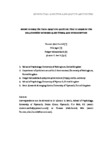Room to breathe: Using adaptive architecture to examine the relationship between alexithymia and interoception
| dc.contributor.author | Abdulhamid, H | |
| dc.contributor.author | Jäger, N | |
| dc.contributor.author | Schnädelbach, H | |
| dc.contributor.author | Smith, Alastair | |
| dc.date.accessioned | 2021-12-17T08:38:26Z | |
| dc.date.issued | 2022-02 | |
| dc.identifier.issn | 0022-3999 | |
| dc.identifier.issn | 1879-1360 | |
| dc.identifier.other | 110708 | |
| dc.identifier.uri | http://hdl.handle.net/10026.1/18475 | |
| dc.description.abstract |
OBJECTIVE: Individuals with alexithymia experience difficulties interpreting emotional states in self and others, which has been associated with interoceptive impairment. Current theories are primarily based on subjective and conscious measures of interoceptive sensitivity, such as heartrate detection, but it is unclear whether similar observations would be found for objective or implicit psychophysiological measures. The present exploratory study assesses the potential of a novel assay through the use of adaptive immersive architecture [ExoBuilding]. METHODS: N = 88 participants were screened for alexithymic traits and N = 27 individuals, representing the range of scores, were sampled to participate in the behavioural task. In a repeated-measures design, participants were placed within ExoBuilding and asked to match their respiration to its movement. Performance was compared to a two-dimensional pacer condition. Behavioural (accuracy) and psychophysiological (Respiratory Sinus Arrhythmia [RSA] and heartrate) measures were compared across conditions, and also related to individual alexithymic traits. RESULTS: Participants with higher levels of alexithymia performed less accurately than participants with lower levels, in both conditions. High-alexithymia participants showed a smaller reduction in heartrate over the course of the ExoBuilding condition than low-alexithymia participants, although there were no differences in RSA between conditions or participants. CONCLUSION: Alexithymia extends beyond conscious interoceptive activities and is also observed in immersive contexts that usually exert psychophysiological effects on typical occupants. These initial findings highlight the importance of considering both conscious and implicit measures of interoception, and we suggest ways in which theories of alexithymia might benefit from capturing this distinction. | |
| dc.format.extent | 110708-110708 | |
| dc.format.medium | Print-Electronic | |
| dc.language | en | |
| dc.language.iso | en | |
| dc.publisher | Elsevier | |
| dc.subject | Interoception | |
| dc.subject | Alexithymia | |
| dc.subject | Adaptive architecture | |
| dc.subject | Respiratory sinus arrhythmia | |
| dc.title | Room to breathe: Using adaptive architecture to examine the relationship between alexithymia and interoception | |
| dc.type | journal-article | |
| dc.type | Journal Article | |
| plymouth.author-url | https://www.webofscience.com/api/gateway?GWVersion=2&SrcApp=PARTNER_APP&SrcAuth=LinksAMR&KeyUT=WOS:000737299100005&DestLinkType=FullRecord&DestApp=ALL_WOS&UsrCustomerID=11bb513d99f797142bcfeffcc58ea008 | |
| plymouth.volume | 153 | |
| plymouth.publication-status | Published | |
| plymouth.journal | Journal of Psychosomatic Research | |
| dc.identifier.doi | 10.1016/j.jpsychores.2021.110708 | |
| plymouth.organisational-group | /Plymouth | |
| plymouth.organisational-group | /Plymouth/Faculty of Health | |
| plymouth.organisational-group | /Plymouth/Faculty of Health/School of Psychology | |
| plymouth.organisational-group | /Plymouth/REF 2021 Researchers by UoA | |
| plymouth.organisational-group | /Plymouth/REF 2021 Researchers by UoA/UoA04 Psychology, Psychiatry and Neuroscience | |
| plymouth.organisational-group | /Plymouth/Users by role | |
| plymouth.organisational-group | /Plymouth/Users by role/Academics | |
| plymouth.organisational-group | /Plymouth/Users by role/Researchers in ResearchFish submission | |
| dc.publisher.place | England | |
| dcterms.dateAccepted | 2021-12-16 | |
| dc.rights.embargodate | 2022-12-22 | |
| dc.identifier.eissn | 1879-1360 | |
| dc.rights.embargoperiod | Not known | |
| rioxxterms.versionofrecord | 10.1016/j.jpsychores.2021.110708 | |
| rioxxterms.licenseref.uri | http://www.rioxx.net/licenses/all-rights-reserved | |
| rioxxterms.licenseref.startdate | 2022-02 | |
| rioxxterms.type | Journal Article/Review |


